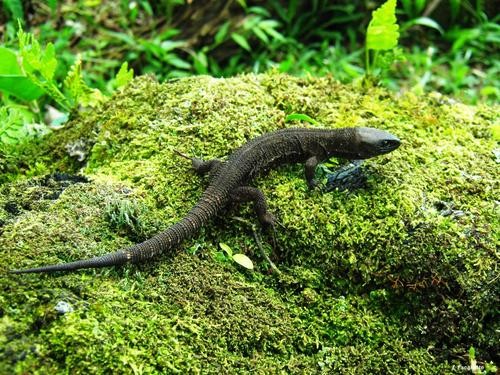Tuxtla tropical night lizard
A species of Tropical night lizards Scientific name : Lepidophyma tuxtlae Genus : Tropical night lizards
Tuxtla tropical night lizard, A species of Tropical night lizards
Scientific name: Lepidophyma tuxtlae
Genus: Tropical night lizards
Content
Description General Info
 Photo By escalante-pasos , used under CC-BY-4.0 /Cropped and compressed from original
Photo By escalante-pasos , used under CC-BY-4.0 /Cropped and compressed from original Description
Tuxtla tropical night lizard is an elusive creature, largely nocturnal and famously secretive in its habits. This species thrives in a niche environment, preferring arid regions with rocky substrates, demonstrating remarkable adaptations to desert life. It's specially adapted to capture small invertebrates under the darkness of night air. In an evolutionary marvel, tuxtla tropical night lizard is renowned for its astonishing freezing tolerance, a sophisticated survival mechanism that enables it to weather the intermittent cold snaps characteristic of its desert domain.
General Info
Lifespan
5-10 years
Diet
Tuxtla tropical night lizard primarily subsists on a diet of arthropods. This nocturnal tropical lizard has a penchant for various invertebrate animals, with a distinct preference for insects such as beetles and spiders, which represent a significant proportion of its nutritional intake.
Appearance
Tuxtla tropical night lizard is a small nocturnal lizard, typically about 7 to 13 cm long. It has a robust body and a noticeably short tail. Its durable skin is rough with a granular texture. The main coloration of its body is brownish gray, often acquiring a pinkish hue. There are no distinct markings or patterns. There's no significant difference in the appearances of its genders or ages, except for juveniles which are a tad brighter in color.
Behavior
Tuxtla tropical night lizard have an essentially fossorial lifestyle, spending the daytime concealed in a variety of shelter sites, including among leaf litter and under logs. Their activity is predominantly nocturnal, foraging under the cover of darkness. This species has a solitary behavior with limited social interactions. Notably adaptable, they exhibit defensive behavior by flattening their body to appear larger when threatened.
Population
Decreasing
Scientific Classification
Phylum
Chordates Class
Reptiles Order
Lizards and snakes Family
Night lizards Genus
Tropical night lizards Species
Tuxtla tropical night lizard